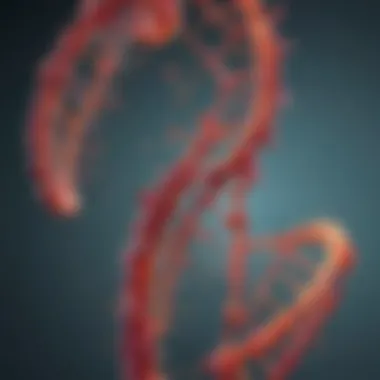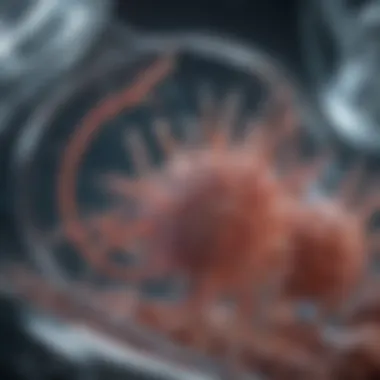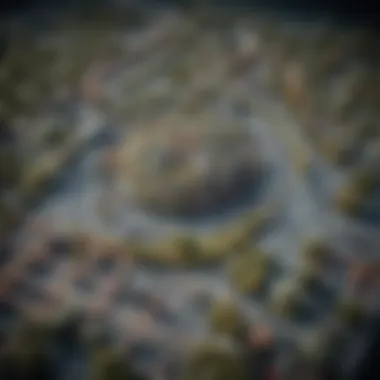Site-Directed Mutagenesis: Techniques and Applications


Intro
Site-directed mutagenesis (SDM) is an essential technique in molecular biology, enabling scientists to make precise alterations to DNA sequences. This process holds significant relevance in genetics and biotechnology, as it provides a clearer understanding of gene functions and the intricate details of protein behavior.
The method allows researchers to target specific nucleotides within a genome, leading to the introduction of mutations that can help unravel the complexities of biological systems. From studying the role of a gene in development to developing therapeutic proteins, SDM serves a multitude of applications that have transformative implications in science.
Research Overview
Summary of Key Findings
Research in site-directed mutagenesis highlights its effectiveness in facilitating a deeper analysis of gene function. Studies demonstrate how targeted mutations can reveal the relationship between a gene's structure and its biological activity, providing insights critical for both fundamental and applied science. With technology's evolution, SDM has seen enhancements that improve its efficiency and accuracy.
Research Objectives and Hypotheses
The primary objective of this research is to explore the mechanisms and methodologies of site-directed mutagenesis. The hypothesis is that specific site changes in DNA can be engineered to achieve desired outcomes in gene function and protein characteristics. Understanding these dynamics can lead to improved applications in genetic engineering and synthetic biology.
Methodology
Study Design and Approach
The methodology encompasses robust experimental designs leveraging SDM. Key techniques include polymerase chain reaction (PCR) and oligonucleotide-based strategies to create desired mutations. The designs are typically structured around hypothesis testing, where the aim is to validate specific predictions regarding gene behavior or protein function.
Data Collection Techniques
Data collection often involves sequencing and functional assays to assess the consequences of introduced mutations. Sequencing helps confirm successful mutagenesis, while assays provide insights into the functional implications of these changes. The integration of techniques such as Next-Generation Sequencing (NGS) enhances the ability to analyze multiple mutations in parallel, yielding comprehensive data.
Preface to Site-Directed Mutagenesis
Site-directed mutagenesis (SDM) is a transformative technique utilized within molecular biology for precise manipulation of genetic material. By enabling specific alterations in DNA sequences, this method is crucial for characterizing gene function, dissecting protein interactions, and even developing new therapeutics. SDM empowers researchers to create mutations that can lead to profound insights into biological processes.
The relevance of this method extends beyond simple genetic engineering; it provides a framework for exploring the intricacies of biological systems. Through targeted changes, scientists can observe resultant phenotypic changes and gain a comprehensive understanding of gene regulatory mechanisms. The ability to modify a single nucleotide can reveal how subtle shifts affect protein stability, activity, or affinity for other molecules. Thus, site-directed mutagenesis is not only a tool for biotechnological applications but also a means to engage with fundamental questions in genetics.
Definition and Overview
Site-directed mutagenesis refers to a variety of techniques used to intentionally introduce mutations at specific locations in a DNA sequence. This allows scientists to change amino acids in proteins, adjust regulatory elements, or even incorporate novel traits into organisms. The process typically starts with a DNA template. Based on the desired mutation, primers are designed to amplify the target region. The resulting alterations can lead to changes in the resultant protein, which can then be studied to assess its new functions or characteristics.
Different methods deploy various strategies for achieving these desired mutations. Techniques such as polymerase chain reaction (PCR), oligonucleotide-directed mutagenesis, and CRISPR-Cas9 have gained traction due to their efficiency and precision. Each method carries unique advantages and procedures, making it crucial for researchers to select the appropriate technique based on their specific objectives.
Historical Context
The concept of introducing mutations into DNA can be traced back to the early days of molecular biology. However, substantial advancements began in the late 20th century when the first techniques for site-directed mutagenesis emerged. Developed by researchers like Kunkel et al., these early methods utilized isolated plasmids and relied on techniques such as hybridization and transformation to incorporate desired mutations.
As technology advanced, so did the efficiency and versatility of SDM techniques. The introduction of PCR in the 1980s revolutionized the field, allowing for rapid amplification of DNA fragments and simplifying the mutagenesis process. This culminated in widely adopted methodologies, each tailored for specific research needs. The ongoing development reflects the dynamic nature of molecular biology, where techniques continue to evolve, enabling deeper investigations into genetic functions and interactions.
With these innovations, site-directed mutagenesis has become an invaluable tool not just in research labs but also in educational settings. By providing hands-on experience with gene editing, it has empowered a new generation of scientists to explore the potentialities of genetics and molecular biology in greater detail.
Site-directed mutagenesis remains at the forefront of genetic research, revealing complexities of life at the molecular level.
In summary, site-directed mutagenesis serves as a foundation for genetic exploration. The historical progression of techniques has enhanced scientific understanding and fostered the development of new biotechnological applications.
Fundamental Principles
Understanding the fundamental principles of site-directed mutagenesis is crucial for its application in molecular biology. This section explores the basic concepts that underpin this powerful technique, focusing on its relevance in gene editing, protein engineering, and therapeutic development. A clear grasp of these principles is necessary for researchers and educators involved in genetic manipulation.


DNA Structure and Function
DNA, or deoxyribonucleic acid, serves as the hereditary material in virtually all living organisms. Its structure is a double helix composed of nucleotide units, each containing a sugar, a phosphate group, and a nitrogenous base. The sequence of these bases encodes genetic information, dictating an organism's traits.
- Base Pairing: The specific pairing of adenine with thymine and cytosine with guanine is fundamental to DNA replication and transcription.
- Gene Function: Each gene in DNA directs the synthesis of a specific protein, influencing cellular functions and ultimately affecting the organism’s phenotype.
A clear understanding of DNA structure and the function of genes is essential. It helps researchers manipulate specific segments for desired outcomes in experiments and applications.
Mechanisms of Mutation
Mutations are changes in the DNA sequence, and they can occur naturally or be induced artificially through techniques like site-directed mutagenesis. Understanding how these mutations arise is key to utilizing them effectively. There are various mechanisms by which mutations can occur:
- Spontaneous Mutations: These happen during DNA replication due to errors made by DNA polymerases. The error rate is usually low, yet these mistakes can accumulate.
- Induced Mutations: These are caused by external factors, such as radiation or chemical agents. Researchers can leverage these factors to create specific mutations that serve intended experimental purposes.
A detailed look at the mechanisms of mutation provides insight into how targeted changes can lead to significant advancements. For instance, by precisely inducing mutations, scientists can analyze gene functions and redesign proteins with improved characteristics, leading to innovations in gene therapy and biotechnology.
"Site-directed mutagenesis revolutionizes our understanding of gene functions and promotes breakthroughs in the development of novel therapeutics."
Techniques of Site-Directed Mutagenesis
The field of molecular biology has evolved significantly, in part due to the utility of site-directed mutagenesis. This technique enables precise alterations to DNA, facilitating a deeper understanding of gene function and the engineering of novel proteins. The advancements in techniques directly influence the outcomes of experiments and applications across research domains. Each method carries its unique advantages and limitations, making the choice of technique crucial for the intended application. Let's delve into specific methodologies that exemplify the principles of site-directed mutagenesis.
Polymerase Chain Reaction (PCR)-Based Methods
Polymerase Chain Reaction (PCR)-based methods are perhaps the most widely utilized techniques in site-directed mutagenesis. This method amplifies specific DNA sequences and allows for strategic modifications at desired locations. The ease of PCR enables rapid experimentation, minimizing both time and resources. One popular approach is the use of overlapping PCR. In this method, two pairs of primers are designed. The first round of amplification generates two DNA fragments with overlapping ends. These fragments are then combined and amplified again.
Effective use of PCR requires precision in primer design; short mismatches can lead to unintended mutations.
Advantages of PCR-based methods include:
- Simplicity: This method requires standard laboratory equipment.
- Speed: PCR amplifications can be completed in a matter of hours.
- Flexibility: It is adaptable for various DNA templates.
Limitations include the possibility of off-target mutations and the dependency on high-fidelity polymerases to ensure accuracy during amplification.
Nicking Methodologies
Nicking methodologies represent another strategic approach in site-directed mutagenesis. This technique employs restriction enzymes that introduce single-strand breaks in the DNA. After nicks are created, a DNA repair mechanism can be harnessed to introduce desired mutations. The repair process can incorporate altered oligonucleotides during the repair cycle, leading to precise modifications.
These methodologies offer significant control over mutation insertion but necessitate careful enzyme selection and optimization. The main advantages of nicking methodologies include:
- High specificity: The introduction of nicks can lead to fewer unintended changes.
- Targeted delivery of mutations: Strategies can be tailored for specific applications.
However, challenges remain in achieving consistent results without unintended consequences. Optimization of reaction conditions is critical in these approaches.
Oligonucleotide Directed Mutagenesis
Oligonucleotide-directed mutagenesis uses short synthetic oligonucleotides to create specific mutations in the target DNA sequence. In this approach, the oligonucleotides serve as primers that incorporate the desired changes. This method allows for precise nucleotide substitutions, insertions, or deletions, and is particularly useful for studying the effects of single amino acid changes.
Benefits of using oligonucleotide-directed mutagenesis include:
- Precision at the nucleotide level.
- Useful for creating specific mutations that may be difficult to achieve with other methods.
Nevertheless, mistakes can occur, and careful design of the oligonucleotide sequence and corresponding controls is essential.


CRISPR-Cas9 Technology
CRISPR-Cas9 technology has revolutionized genetic engineering and is among the most advanced methods of site-directed mutagenesis. By utilizing a guide RNA that directs the Cas9 enzyme to the specific target site in the genome, researchers can induce double-strand breaks. Afterward, the cellular repair mechanisms can be exploited to introduce desired mutations. CRISPR’s precision allows for multiple sites to be targeted simultaneously, which expands its application potential.
The advantages of CRISPR-Cas9 include:
- Efficiency in targeting multiple genes.
- Cost-effectiveness, as it reduces the time and materials needed compared to traditional methods.
However, off-target effects remain a significant concern. Researchers must implement robust validation methods to ensure the integrity and intended outcomes of their modifications.
In summary, the techniques of site-directed mutagenesis offer diverse approaches for altering genetic material. Each method has its benefits and constraints. The choice of technique largely depends on the specific goals of an experiment, and understanding these methodologies is crucial for effective application in molecular biology.
Applications of Site-Directed Mutagenesis
Site-directed mutagenesis is a crucial technique that plays a significant role across various domains in molecular biology. Its versatility allows researchers to investigate the function and structure of genes and proteins, thereby driving advancements in genetics and biotechnology. The applications can be seen in areas such as gene function analysis, protein engineering, the development of therapeutics, and the creation of animal models. Understanding these applications provides vital context for the importance of mutagenesis in both basic and applied research.
Gene Function Analysis
Gene function analysis through site-directed mutagenesis can enhance our understanding of biological processes. By creating specific mutations, scientists can examine how alterations in genetic sequences affect gene expression and protein function. This targeted approach can clarify the role of particular genes in development or disease mechanisms.
For instance, a mutation introduced in a regulatory region of a gene may demonstrate its influence on transcription levels. Experiments can reveal if specific amino acid changes impact protein interactions or enzymatic activity. As a result, this method contributes to elucidating pathways involved in diseases such as cancer, diabetes, or genetic disorders. Ultimately, locating causal mutations aids in identifying potential therapeutic targets.
Protein Engineering
Protein engineering is another area where site-directed mutagenesis proves invaluable. Utilizing this technique, researchers can modify proteins to enhance their stability, activity, or specificity. This precision leads to the production of novel proteins with desirable traits, which can find applications in various industries, including pharmaceuticals, agriculture, and biofuels.
For example, mutagenesis can help improve enzymatic reactions, making them more efficient under specific conditions. The modification of antibodies to increase their affinity for antigens can also be achieved through targeted mutagenesis. The ability to design proteins that perform specific functions is transforming our approaches in synthetic biology and drug development, making it a significant aspect of modern research.
Development of Therapeutics
The development of therapeutics benefits greatly from advancements in site-directed mutagenesis. By creating models of diseases at the molecular level, researchers can test new drugs and therapeutic approaches more efficiently. The adaptation of proteins for therapeutic use, such as monoclonal antibodies or enzyme replacement therapies, can be achieved by altering their structure through mutagenesis.
Furthermore, targeted mutations can aid in the discovery of drug resistance mechanisms, helping in the design of more effective treatments. For instance, studying how specific mutations in viral proteins confer resistance to antiviral drugs can lead to the development of next-generation therapeutics. This application illustrates how understanding genetic alterations helps pave the way for innovative treatments in personalized medicine.
Creation of Animal Models
Creating animal models for research is another pivotal application of site-directed mutagenesis. Animals such as mice can be genetically modified to carry specific mutations, allowing scientists to replicate human diseases more accurately. This capability is critical for studying pathophysiological processes and evaluating potential treatments.
The generation of knockout or knock-in models enables more precise investigation of gene function in vivo. For instance, a knock-out model lacking a specific gene can help elucidate its role in development or pathology. Such models greatly facilitate the testing of pharmacological interventions and enhance the translational potential of research, bringing valuable insights into human health and disease mechanisms.
"Site-directed mutagenesis is not just a tool; it is a gateway to unparalleled understanding of molecular biology and therapeutics."
Challenges in Site-Directed Mutagenesis
Site-directed mutagenesis is not without its obstacles. Understanding these challenges is crucial for both researchers and practitioners in molecular biology. This section focuses on aspects that affect the efficiency and outcomes of mutagenesis. Key issues include precision and accuracy, off-target effects, and ethical considerations, all of which play significant roles in the application of this technique.
Precision and Accuracy
Achieving high precision and accuracy in site-directed mutagenesis is vital for successful experiments. Even minor discrepancies can lead to incorrect interpretations of results or unintended consequences in biological systems. The design of primers is one factor influencing this precision. Well-designed primers must ensure that only the targeted sequence is altered, while leaving the remainder of the DNA intact. Inadequate primer design can introduce additional mutations that were not intended.
In addition, the efficiency of the polymerases used in the reactions also impacts accuracy. Some polymerases are more prone to errors than others, which can lead to misincorporations during DNA synthesis. Researchers must choose high-fidelity polymerases to mitigate this risk.
Furthermore, optimization of reaction conditions is needed. Each DNA construct may require different conditions, such as temperature and concentration of reagents, to ensure precise results. Thus, thorough optimization is essential for reliability in experiments.


Off-Target Effects
Off-target effects represent another significant challenge in site-directed mutagenesis. This phenomenon occurs when modifications are made not just to the intended site but also to other regions of the DNA. Such unintended mutations can skew experimental outcomes and mislead researchers about gene function or protein characteristics. The repercussions can be considerable, particularly in critical applications like gene therapy or protein engineering.
Technological advancements, like CRISPR-Cas9, have improved the specificity of gene editing, yet off-target activities remain a genuine concern. Researchers must implement methods to assess off-target effects, typically using sequencing techniques to identify any unintended changes. This step is essential for validating the intended outcomes of the mutagenesis processes.
Ethical Considerations
The ethical implications of site-directed mutagenesis cannot be overlooked. As technologies evolve, discussions surrounding the applications of genetic engineering are becoming more prominent. Scientists are expected to consider the broader consequences of their work, especially when it involves modifications that could affect entire ecosystems or human health.
Questions regarding consent, biosafety, and the impact on biodiversity arise. For example, mutations designed to enhance crop resistance could have unforeseen effects on local ecosystems. Additionally, there are concerns about genetic modifications in animals and humans, particularly regarding the potential for unintended transgenerational effects.
In light of these ethical challenges, researchers are encouraged to adopt responsible practices. Institutional review boards often need to scrutinize proposals involving site-directed mutagenesis to ensure that ethical standards are maintained.
Ethics must always remain at the forefront of scientific progression.
Future Directions in Site-Directed Mutagenesis
The future directions in site-directed mutagenesis represent a focal point for innovation and research in molecular biology. As the field evolves, certain elements stand to reshape the methodologies employed and enhance the precision of genetic modifications. As scientists explore novel avenues, both the potentials and challenges will be identified, paving the way for significant advancements.
Emerging Technologies
Emerging technologies are at the forefront of the evolution of site-directed mutagenesis. Recent developments in gene editing techniques such as prime editing and base editing are particularly promising. These methods provide enhanced precision, allowing for target modifications without creating double-strand breaks in the DNA. This can lead to fewer unintended mutations, making the process safer and more effective.
Key components of emerging technologies include:
- Prime Editing: This method allows for highly accurate edits by directly writing new genetic information into a specified DNA site. It addresses several limitations of previous techniques, offering a versatile option for precise mutations.
- Base Editing: Base editing converts one DNA base into another without needing extensive repair mechanisms, minimizing potential errors during the process.
- CRISPR 2.0 technologies: Developing next-generation CRISPR systems that enhance specificity and reduce off-target effects continually expands the possibilities of targeted mutagenesis.
These advancements hold promise not only for research but also for therapeutic applications. As therapies become more precise, patients may experience fewer side effects, further increasing the interest in these emerging methodologies.
Integrating Artificial Intelligence
Integrating artificial intelligence (AI) into site-directed mutagenesis offers an exciting dimension to the field. AI can analyze vast datasets quickly, identifying patterns and predicting outcomes. This presents an opportunity to increase efficiency in designing experiments and selecting target sites for mutagenesis.
Some vital areas where AI can influence site-directed mutagenesis are:
- Design Efficiency: AI algorithms can assist in generating optimized primers and guide RNAs for various mutagenesis techniques, speeding up the design process considerably.
- Predictive Modeling: By analyzing existing genetic modifications and their outcomes, AI can help predict the success of future experimental strategies, enhancing decision-making processes for researchers.
- Data Analysis: Processing the large datasets generated from sequencing assays, AI can detect mutations and analyze their implications, providing deeper insights into gene function and interactions.
As researchers increasingly adopt AI tools, the prediction accuracy and the overall efficiency of site-directed mutagenesis will likely improve. This synergy of biology and technology holds great potential for driving innovations in genetic research and therapeutic interventions.
"Innovation in site-directed mutagenesis not only enhances our understanding of genetics but also opens pathways for novel therapies."
The future of site-directed mutagenesis lies in continuous improvement and exploration of new methods, ultimately enriching our comprehension of genetic mechanisms while improving practical applications in medicine and biotechnology.
Closure
The conclusion serves as a pivotal section in this article, encapsulating the significance and implications of site-directed mutagenesis within the field of molecular biology. It provides a synthesis of the various techniques and applications explored throughout the discourse. Understanding the implications of this powerful methodology allows for a broader appreciation of its role in advancing genetic research and therapeutic developments.
Summary of Key Points
This article has thoroughly reviewed the following essential aspects of site-directed mutagenesis:
- Definition and Overview: Site-directed mutagenesis is defined as a method that enables precise alterations in an organism's DNA, crucial for functional studies in genetics.
- Techniques and Methods: Various techniques like PCR-based methods and CRISPR-Cas9 were discussed. Each approach has its advantages and limitations that define its applicability.
- Applications: This method is widely used in gene function analysis, protein engineering, drug development, and the creation of animal models for research.
- Challenges: Issues such as precision, off-target effects, and ethical considerations were outlined as important factors that researchers must navigate.
- Future Directions: Emerging technologies and the potential integration of artificial intelligence offer exciting avenues for improving the field and tackling current limitations.
Final Remarks on the Importance
Site-directed mutagenesis stands as a cornerstone in molecular biology, shaping our understanding of genetic mechanisms and aiding in the development of novel therapeutics. The precision with which scientists can now manipulate genes opens new doors for research innovations. The method not only enhances the ability to study gene function but also paves the way for advancements in personalized medicine. Moreover, ongoing research and development in this field ensure that the potential of site-directed mutagenesis will continue to expand, addressing both current and future challenges in molecular biology.
In a world where genetic advancements are rapidly evolving, the importance of mastering techniques like site-directed mutagenesis cannot be overstated. These methodologies not only empower researchers with tools to explore biological questions but also enhance the capabilities to engineer solutions for complex health issues. Ultimately, site-directed mutagenesis plays a vital role in the journey toward unlocking the mysteries of genetics.













